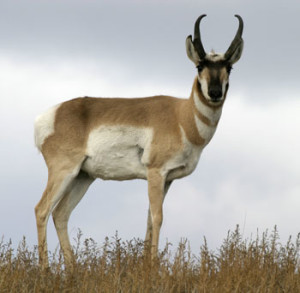Nature Notes by Dr. Frank Lang
One summer some visiting Japanese botany colleagues wanted to collect arid land species to analyze for exotic chemicals. I took them to Harney County: land of the Stinking Water and Pueblo Mountains, the Alvord Desert and Steens Mountain, one of North America’s great natural wonders. It was a land more arid than usual, although aridity was placed in perspective when I noticed the bison skull in the Buchanan Store collected from the bottom of Malheur Lake when it dried up in 1932.
Dave Kennedy, the expedition’s majordomo, and I excitedly pointed out wildlife when we saw it. Like the coyote who tried unsuccessfully to nail a sandhill crane in a field outside Diamond, Oregon, or deer herds, or antelope. David and I were taken by the pronghorns; our guests were not. How could anyone not be excited about pronghorns, North America’s own special ruminant, neither sheep nor goat? How could one not get excited about seeing a doe and fawn slowly meandering across a flat near he head of gorgeous Big Indian Gorge?

But pronghorns are fascinating. They are fast, clocked at a maximum 57 miles per hour for nine miles. Normal running speed is about 24 miles per hour. Wiley coyote has a problem. Pronghorns can adapt quickly to new conditions, the urban fringe, traffic noise, and gardens. They signal one another with their flashy white rump patches. They are curious, something that doesn’t always work to their advantage. They are short-lived, nine years at most. They shed their black, short, forked horns each year like a Bowie knife’s leather sheath. The smooth, skin-covered “knife” remains attached to produce new horns of agglutinated hair for next year’s frolics.
Nature has decreed death to all but two of the four to six embryos that implant in the uterus in pregnant pronghorns. Sharpened membranes of a pair of embryos puncture vital membranes of their womb mates. The damaged embryos die of no nutrition and are reabsorbed by mother. The remaining pair survive for birth.
Had my Japanese friends visited the Rogue Valley in 1841, not 1992, we would not have had to travel all the way to Steens to see pronghorns.
The Rogue Valley, September 1841:
An antelope was killed, which was one of four that the hunters had seen; it was of a dun and white color, and its hair was remarkably soft. The Indians take this animal by exciting its curiosity: for this purpose they conceal themselves in a bush near its feeding grounds, and making a rustling noise soon attracting its attention, when it is led to advance towards the place of concealment until the arrow pierces it. If there are others in company, they frequently remain with the wounded until they are all in like manner destroyed. This species of antelope, according to the hunters, only inhabits the prairie, being seldom seen even in the open country. The flavor of the meat was thought to be superior to that of deer.
From the narrative of the US Exploring Expedition,
Lt. Charles Wilkes, Commander.
Wow, pronghorns on the Agate Desert, and large herds on the Klamath, towards Mount Shasta, according to the narrative. Pronghorns extirpated from their former range. Extirpated, a term we use more and more, as we intentionally or inadvertently elbow our fellow creatures from the path of progress.
— Dr. Frank Lang
Other pages in this section
- Dr Frank Lang obituary, May 14, 1937 – June 26, 2019
- Alkali Flies
- Bald Eagles
- Bull Trout
- Christmas Trees
- Cryptosporidiosis
- Cucurbits
- Dicamptodon
- Dippers
- Earthworms
- Fens
- Fishing
- Grapeferns
- Helliborine Orchid
- Habitat
- Hairy Woodpecker
- Hibernation
- Klamath Midge
- Marshes
- More Yellowjackets
- Morels
- Mosquito Fern
- Mountain Beaver
- Myriapods
- Painted Ladies
- Pandora Moths
- Pikas
- Raccoons
- Robins
- Shaggy Manes
- Silver-Gray Squirrels
- Slugs
- Soils
- Songbirds
- Spotted Owl
- Spotted Skunk
- Subalpine Fir
- Ticks and Mites
- Water
- Watermelon Snow
- Water Bears
- Wizard Island Toads
- Wocas
- Woodrats
- Yellowjackets
- Dr Frank Lang obituary, May 14, 1937 – June 26, 2019
- Alkali Flies
- Bald Eagles
- Bull Trout
- Christmas Trees
- Cryptosporidiosis
- Cucurbits
- Dicamptodon
- Dippers
- Earthworms
- Fens
- Fishing
- Grapeferns
- Helliborine Orchid
- Habitat
- Hairy Woodpecker
- Hibernation
- Klamath Midge
- Marshes
- More Yellowjackets
- Morels
- Mosquito Fern
- Mountain Beaver
- Myriapods
- Painted Ladies
- Pandora Moths
- Pikas
- Raccoons
- Robins
- Shaggy Manes
- Silver-Gray Squirrels
- Slugs
- Soils
- Songbirds
- Spotted Owl
- Spotted Skunk
- Subalpine Fir
- Ticks and Mites
- Water
- Watermelon Snow
- Water Bears
- Wizard Island Toads
- Wocas
- Woodrats
- Yellowjackets

